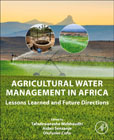
Agricultural Water Management in Africa: Lessons Learned and Future Directions
Mabhaudhi, Tafadzwanashe
Senzanje, Aidan
Cofie, Olufunke
Agricultural Water Management in Africa: Lessons Learned and Future Directions provides an overview of the status of irrigation development and AWM practices and technologies in Africa and the global south. In addition, it provides guidelines, scenarios, and investment plans to guide the prioritization and operationalization of irrigation development and AWM under climate change. The African Union (AU) is driving investment and improvement in agricultural water management and transformation in Africa through the operationalization of the AU Irrigation Development and Agricultural Water Management in Africa (AU-IDAWM). The AU-IDAWM provides a framework that identifies four development pathways for enhanced agricultural water management practices across Africa. The pathways are as follows: (1) Pathway 1: Improved water control and watershed management in rain-fed farming, (2) Pathway 2: Farmer-led Irrigation Development (FLID), (3) Pathway 3: Irrigation scheme development and modernization, and (4) Pathway 4: Unconventional water use for irrigation. Highlights fit-for-purpose irrigation strategies at scale and identifies opportunities and challenges of irrigation practicesExpands understanding of the pathways for AWM, presenting operation and maintenance proceduresIncludes bespoke designs guided by AWM pathway approach INDICE: 1. IntroductionSECTION A: Concepts and Overview2. Agricultural Water Management: an overview of concepts3. The Status of Agricultural Water Management in Africa: progress, challenges, and opportunities4. Improving AWM solutions: pathways to enhancing resilience, food, and water security across scalesSection B: Regional case studies - Africa5. Status of AWM in East Africa6. Status of AWM in Central Africa7. Status of AWM in the North Africa8. Status of AWM in Southern Africa9. Status of AWM in West AfricaSECTION C: Lessons from the global South10. South Asia11. Central Asia and the Middle East12. Latin America13. Indian sub-continentSECTION D: Cross-cutting issues14. Relevance of the water-energy-food nexus for improving AWM under climate change15. Water, climate and disaster risks and sustainable and resilient food systems: the context for IDAWM16. Circular economy: enhancing the transition to and adoption of unconventional water use for irrigation17. Perspectives to scaling transformative approaches for food, land and water systems.18. Gender, youth and social inclusion for AWMSECTION E: Synthesis, conclusion, and recommendations19. What does the future of AWM in Africa look like under climate change?
- ISBN: 978-0-443-21584-1
- Editorial: Academic Press
- Encuadernacion: Rústica
- Páginas: 400
- Fecha Publicación: 01/12/2024
- Nº Volúmenes: 1
- Idioma: Inglés
